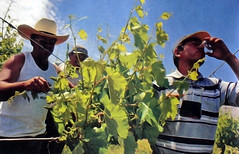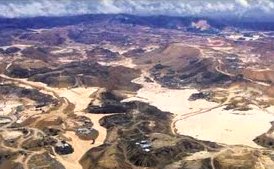There have been so many ancient cultures in Peru who have gone on to create so many citadels, farming terraces, temples and pyramids that you often only need to climb the nearest hill to find remnants of their existence. Because of this the vast majority of the country’s archaeological sites are relatively unknown, unvisited and unprotected.
Category: "Archaeology"
The Huaca Centinela and the Chincha culture
The Huaca Centinela was one of the principle centres of the Chincha people, a group of farmers, fishers and merchants that lived in the fertile valley that is now named for them. The Chincha nation existed in the area between the years 900 and 1495 when they were folded into the Inca Empire.
Earliest Gun Shot Victim in the New World
Puruchuco, the site in Ate I visited not so long ago, has turned up yet more spectacular finds. In the Inca cemetery not far from the ruins in which 2500 mummies have been excavated, archaeologists uncovered what appeared to be a skeleton with a Spanish musket ball hole in the back of its skull. The traces of iron in the skull, from which Spanish muskets balls were made, seems to confirm this.
Dating of artefacts buried alongside the bodies allowed them to date the burials to an extraordinary time – about one year after the Spanish had founded the city of Lima.
Los Tallanes and the city of Narihualá
The Tallán nation was perhaps the first civilisation in the northern Peruvian region of Piura and controlled the area of the Piura and Chira rivers, and the coast. Their society was matriarchal, where the men would do the work and the women would make the decisions. They had their own gods and their own distinct language and customs. They had an economy based on fishing, farming and artisan making and monumental temples of adobe and a system of aqueducts to create fertile farm land.
Puruchuco
The Inca palace of Puruchuco is one of the most impressive ruins in Lima and is one of the best restored and the first to have been done so properly. It can be found seated at the foot of a cerro in the district of Ate, at the start of the Andes mountain range.
Khipu – Pre-Columbian Communication
It is often said that the Incas and their forebearers didn’t have a writing system — such statements were often made by their conquerors to belittle them. This belief has slowly become the norm. But it seems they did have a system, they just wrote down what they wanted to say with knots on a string rather than symbols on paper. You can see examples in museums across Peru and collections throughout the world.
Huaca Pucllana
In the centre of Miraflores in the city of Lima resides a large mound of dry mud that rises above the surrounding buildings. Close to the rising mountains of the Andes such a thing doesn’t seem entirely out of place – until you look closer. Those are bricks… terraces… stairs. Could it be that this formation is man-made?
Ecuador: Ingapirca
The Cañaris, a strong and proud people, didn’t want to submit to the Incas, as many other civilisations had done when the empire was being expanded into what is now Chile/Argentina and Ecuador/Colombia.
When the Inca armies finally did bring the Cañaris and other peoples from what is now Ecuador under their control they incorporated their cities and religious centres into their own. This is what happened to the formally Cañari ruins at Ingapirca, the heart of Cañari territory.
Ollantaytambo – Inca Ruins
The Spanish had caused the Inca empire to collapse. The pacific coast was theirs, they had founded the city of Lima. Marching on Cuzco they entered without a fight. The Inca emperor had been put to death, and the city of Cuzco was pillaged. The Spanish had installed a puppet emperor who was to do their bidding while they looted the empire for gold and forced the people into Christianity.
Machu Picchu
Machu Picchu means “old peak” in the Inca language of Quechua, as Huayna Picchu the thin point mountain at the other side of the ruins means “young peak”. These are not Inca names, we don’t know what they called the mountain, nor their city, rather the name was given by a geographer and cartographer working to document the region…
Pisaq – Inca Ruins
The spectacular ruins of the grand Inca city of Pisaqa. Perched on a mountain ridge high above the Urubamba valley…
Puka Pukará
This small set of ruins sits on a hilltop. It is assumed it was a fort as it commands views of the entire area and its name in Quechua means “Red Fort”. It isn’t as simple as that though as the place is quite small. Perhaps it was more of a guard post.
There are numerous storage areas for storing grain and cereals, it also has some places to sleep.






![Gastón’s La Mar in San Francisco [Featured]](http://farm4.static.flickr.com/3648/3351155372_6e43bf5e92_m.jpg)


